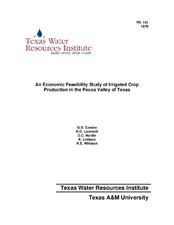| dc.description.abstract | Public concern over the potential effects of energy price increases on the U.S. food and fiber system has been dramatically justified in the Trans Pecos region of Texas where a 450 percent increase in the price of natural gas was followed by the idling of thousands of irrigated acres and the departure of many of the farmers.
This study was conducted to provide the answers to two questions: (l) Can an irrigated farm survive in the Trans Pecos? and (2) If it survives, how profitable will it be? Coyanosa, one of the irrigated areas of the Trans Pecos, was selected as a study area, and the St. Lawrence area of the Edwards Plateau was selected to provide comparative estimates of survival and profitability.
A modified MOTAD linear programming-simulation model was developed to generate estimates of survival and profitability by recursive simulation of multiple time periods, as follows: (l) development of a farm plan, (2) generation of stochastic prices and yields, (3) simulation and evaluation of the farm plan in operation, and (4) update of the planning situation to reflect adjustments in expected prices, expected yields, and credit restrictions. The model then returns to step l for simulation of the next time period.
The model was applied to the Coyanosa and St. Lawrence regions under alternative future scenarios for inflation rates, energy prices, crop prices, and interest rates. The Coyanosa model was also applied under most likely scenario conditions to analyze the effects of alternative levels of risk-aversion and alternative tenure situations. Each application included 20 simulations of a 1O year planning horizon to develop a distribution of outcome.
The Coyanosa farm survived about 8 years under the optimistic scenario and 5 years under all other scenarios. The most likely rate of survival was 20-30 percent with a range of 1O percent to 65 percent for other scenarios. The average life and rate of survival was higher for the St. Lawrence farm under all scenarios.
The internal rate of return on equity capital for the Coyanosa farm was 36.8 percent under the optimistic scenario and negative under all other scenarios. The rate of return for St. Lawrence was not significantly different for the optimistic scenario; however, it was higher than Coyanosa for all other scenarios.
The level of risk-aversion described by the baseline model appears to be relatively high compared to other studies, but there are indications that it may be relatively low for the St. Lawrence area. Both rate of return and survival increased in response to decreased levels of risk-aversion, however, the latter result may be related to the specification of the risk restraint.
Land purchase provided higher estimates of survival and profitability than rental or combined rental and purchase. These results seem to relate to the finding that traditional crop share rental arrangements are unsatisfactory for the Coyanosa area.
It was concluded from this study that (l) survival and profitability of irrigated crop production in the Coyanosa area will depend greatly upon future levels of inflation, energy prices, crop prices, and interest rates, (2) survival and profitability for Coyanosa will most likely be lower than St. Lawrence, and (3) land purchase provides greater potential survival and profitability than traditional crop share rental arrangements. These conclusions were limited by need for additional research regarding the effects of beginning equity levels and consideration of risk in farm planning. Conclusions were also limited by the data and assumptions utilized in the study. | en |


